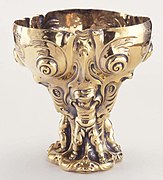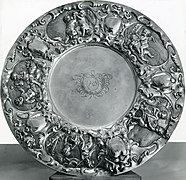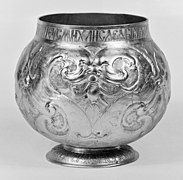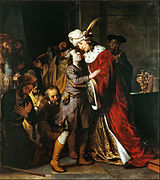Auricular style

The auricular style or lobate style (Dutch: Kwabstijl, German: Ohrmuschelstil) is a style of ornamental decoration, mainly found in
In some other European languages, the style is covered by the local equivalent of the term
Metalwork

Although precedents have been traced in the graphic designs of Italian
In metalwork, the style was in harmony with the malleable nature of the material, often giving the impression that the object is beginning to melt. It contrasted strongly with the preceding
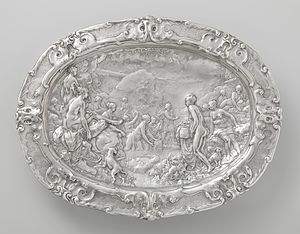
Key works
Most of the key works are in the Netherlands, especially the
The Adam van Vianen ewer is "a strikingly original work that is largely abstract and completely sculptural in its conception", and was commissioned by the Amsterdam goldsmiths' guild to commemorate the death of Paul, despite neither brother living in Amsterdam or being a member of the guild.[10] The piece became famous and appears in several Dutch Golden Age paintings, both still lifes and history paintings, "no doubt in part because its bizarre form allowed it to pass as an object from an ancient and foreign land", and so useful for Old Testament scenes and the like.[11] According to James Trilling, it "is one of the very few ornamental works that deserve recognition as art-historical turning points. Van Vianen's breakthrough was the introduction of inchoate or indeterminate form, which paved the way for both Rococo and modernist ornament."[12] It was raised by a lengthy process of chasing from a single sheet of silver, and chasing was the main technique used in auricular silver.[13]
The
The "Dolphin Basin", which presumably once had a matching ewer, is an asymmetric form with watery motifs by Christian van Vianen (1635), now in the Victoria and Albert Museum in London.[15]
-
Christian van Vianen, Standing cup, 1640-41, Waddesdon Manor
-
Dish, by Philippus Lude
-
Russian, drinking cup (Bratina)
-
Print after silver jug by Adam or Christian van Vianen
-
Detail of a Lutma dish
-
Detail of brass choir-screen by Lutma, Nieuwe Kerk, Amsterdam
-
The Adam van Vianen Memorial ewer in Joseph and his Brothers, by Gerbrand van den Eeckhout
In other media
The style was also effective in carved wood, and used for furniture[16] and especially picture frames.[17] Different varieties became popular in both English and Dutch frames. One English type are known as Sunderland frames after the frames Robert Spencer, 2nd Earl of Sunderland put on the pictures at Althorp, his new country house.[18]

Around the mid-century, Cardinal
The style was effective for cartouches, whether in three-dimensional uses or for bookplates and the like. It later influenced Rococo and then Art Nouveau ornament.[21]
Notes
- ^ Schroder, "[the style] in its fully developed form is found only in metalwork."
- ^ Osborne, 61
- ISBN 9401036977, 9789401036979, google books
- ^ Schroder, "... its origins seem to lie in the graphic designs of such 16th-century Italian Mannerist artists as Giulio Romano (e.g. drawing for a fish-shaped ewer; Oxford, Christ Church) and Enea Vico. The latter’s designs for plate were published in the mid-16th century and may have been known in Utrecht."
- ^ A ewer is illustrated in John Fleming and Hugh Honour, Dictionary of the Decorative Arts, s.v. "Auricular style".
- ^ Osborne, 61
- ^ Walters page on the object
- ^ Liedtke (2001), no. 146 (1630); Schroder
- ^ Schroder lists a number; Rijksmuseum pages: Adam van Vianen 1614, Paulus van Vianen 1613, Lutma 1647
- ^ Schroder in Oxford Art Online, "Adam van Vianen"
- ^ Liedtke (2007), 186-188, giving examples including Joseph and his brothers (this is the Warsaw version) by Gerbrand van den Eeckhout. See the article on the ewer for several more.
- ISBN 0500203431
- ^ Schroder in Oxford Art Online, "Adam van Vianen"
- ^ Rijsmuseum
- ^ The Dolphin Basin by Christian van Vianen, Victoria and Albert Museum
- ^ Designs for chairs in auricular style were published by the furniture-maker Friedrich Untensch, Frankfort-am-Main, ca 1650 (noted in Fleming and Honour 1977).
- ^ Mosco; An example is noted in Harold Osborne, ed. The Oxford Companion to the Decorative Arts, s.v. "Auricular Style" is a frame made by Lucas Killian of Augsburg for his portrait of Elias Holl, 1619.
- ^ Sacorafou, Suzanne, "A ‘Sunderland’ frame", "Auricular Style: Frames project" website.
- ^ Mosco; Davis Deborah, The Secret Lives of Frames: One Hundred Years of Art and Artistry, 54
- ISBN 0892369817, 9780892369812, google books
- ^ Osborne, 61
References
- Liedtke (2001): Liedtke, Walter A. (ed.), Vermeer and The Delft School, 2001, exhibition catalogue from The ISBN 9780870999734, google books
- Liedtke (2007): Liedtke, Walter A. (ed.), Dutch Paintings in The Metropolitan Museum of Art, 2 vols., 2007, ISBN 1588392732, 9781588392732, google books
- Mosco, Marilena, "Anthropomorphism and Zoömorphism in the ‘Medici’ picture frames" one of the papers at the "Auricular Style: Frames project" website in External links below
- Osborne, Harold (ed), The Oxford Companion to the Decorative Arts, 1975, OUP, ISBN 0198661134
- Schroder, Timothy, "Auricular style." Grove Art Online. Oxford Art Online. Oxford University Press, accessed December 15, 2012, Oxford Art Online (subscription required)
External links
- Christiaen van Vianen cup in the collection of Waddesdon Manor
- The Auricular Style: Frames project, with abstracts of papers from a 2016 conference on auricular picture frames, and links to some full texts.

